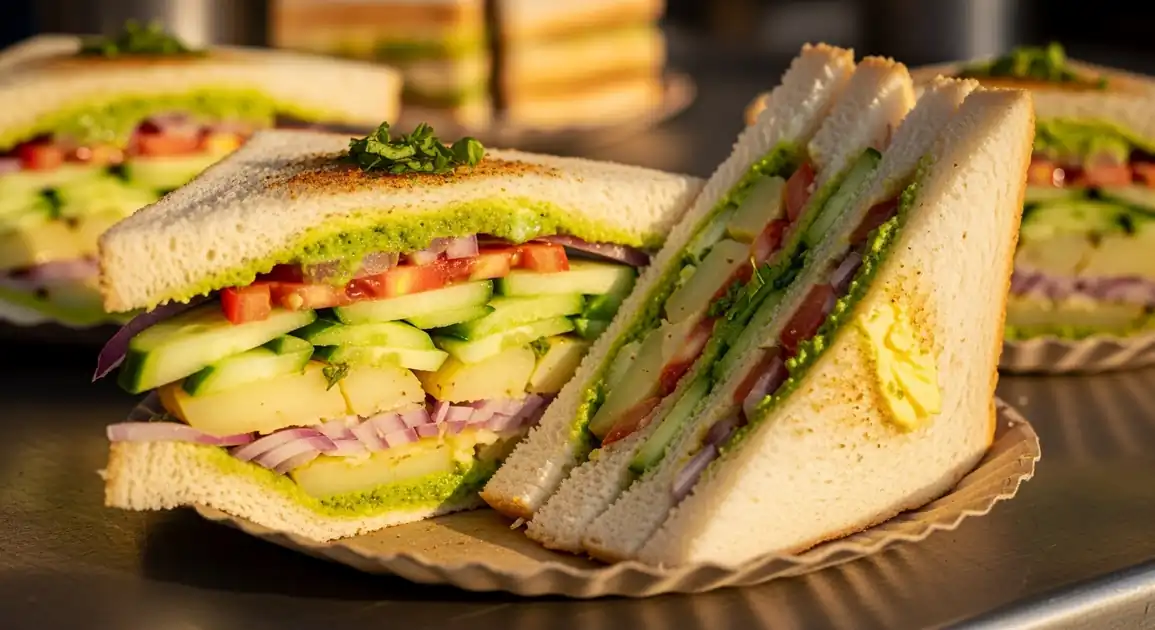Bombay Sandwich
बॉम्बे सैंडविच (Bombay Sandwich)

Description
The Bombay Sandwich is found throughout India, though it originated in Mumbai. In cities across the country, it's a popular quick meal or snack option, with regional variations adapting to local tastes while maintaining the core elements. The sandwich represents the influence of Mumbai's food culture on pan-Indian street food scenes.
Dietary Information
Serving information
Serving style
Typically served wrapped in paper, sometimes with a small paper plate. Often accompanied by a small container or smear of extra green chutney. Eaten by hand while standing at busy street stalls.
Quick facts
Most sandwich vendors operate from 8 AM to 9 PM, with peak business during lunch (12 PM - 2 PM) and evening snack times (4 PM - 7 PM).
Safety Tips
What to Look For
-
Freshly prepared sandwich made to order
A sandwich assembled when you order ensures freshness and minimizes time for potential contamination.
-
Clean preparation area with covered ingredients
Vegetables and bread should be stored in covered containers or display cases, protecting them from dust, flies, and airborne contaminants.
-
Vendor using tongs, spatulas, or gloves
Proper utensils or gloves indicate good hygiene practices and reduce direct hand contact with food.
-
Bright, crisp vegetables without browning or wilting
Fresh vegetables not only taste better but are less likely to cause digestive issues.
-
Steady customer flow indicating high turnover
Popular stalls use ingredients more quickly, meaning fresher components in your sandwich.
What to avoid
-
Pre-made sandwiches sitting out uncovered
Sandwiches prepared in advance and left exposed can collect contaminants and deteriorate in quality.
-
Dirty cutting boards or knives
Cutting implements should be clean, as they come in direct contact with your food.
-
Uncovered vegetables sitting in the sun
Vegetables exposed to heat and air deteriorate quickly and may harbor bacteria.
-
Reuse of butter from previous customers
Some vendors might reuse butter that's been touched with the same knife used on multiple sandwiches.
-
Wet, soggy, or moldy bread
Quality bread should look fresh, be stored properly, and have no visible mold spots.
Price information
Price range
Budget tips
- Plain versions (30-50 INR) are cheaper than grilled (40-70 INR) or cheese options (50-120 INR).
- Prices are typically 20-30% lower at street stalls compared to food courts or cafes.
- Railway station vendors may charge less than those in tourist or business areas.
- Suburban vendors generally charge less than those in central city locations.
Value indicators
- Generous vegetable filling visible in layers
- Freshly made chutney rather than packaged versions
- Good bread-to-filling ratio
- Sandwich cut into manageable triangles
- Complimentary side of extra chutney
Where to Find This Dish
Commercial Areas
Found near office complexes and business districts catering to working professionals.
Office complexes, Business parks, Commercial streets
Lunch (12 PM - 2 PM), Evening (5 PM - 7 PM)
Educational Institutions
Popular among students due to affordability and filling portions.
College campuses, Coaching centers, School peripheries
Afternoon (12 PM - 3 PM), Evening (4 PM - 6 PM)
Transit Hubs
Common sight near railway stations and bus depots.
Railway stations, Bus terminals, Metro stations
Morning (7 AM - 10 AM), Evening (5 PM - 8 PM)
Vendor Tips
- Vendors with a designated person handling money separate from food preparation are preferable.
- If cleanliness is a concern, request the vendor to use a fresh knife for cutting your sandwich.
- For less spicy versions, ask specifically for "kam teekha" (less spicy) chutney.
How to Order
Regional Variations
-
Plain Bombay Sandwich
(सादा बॉम्बे सैंडविच (Saada Bombay Sandwich))
The classic untoasted version with butter, green chutney, and vegetable layers cut into triangles.
-
Grilled Bombay Sandwich
(ग्रिल्ड बॉम्बे सैंडविच (Grilled Bombay Sandwich))
The sandwich is assembled and then toasted on a flat griddle (tava) until crisp and golden, often pressed down with a spatula.
-
Cheese Bombay Sandwich
(चीज़ बॉम्बे सैंडविच (Cheese Bombay Sandwich))
Either the plain or grilled version with the addition of processed cheese slices or grated cheese, melted if grilled.
-
Jain Bombay Sandwich
(जैन बॉम्बे सैंडविच (Jain Bombay Sandwich))
Follows Jain dietary restrictions - excludes onions, garlic, and root vegetables grown underground (except potatoes).
-
Club Bombay Sandwich
(क्लब बॉम्बे सैंडविच (Club Bombay Sandwich))
A triple-decker version with extra layers of bread and vegetables, often served in more upscale eateries.
-
Russian Bombay Sandwich
(रशियन बॉम्बे सैंडविच (Russian Bombay Sandwich))
Despite the name, it's uniquely Indian - includes a layer of cabbage and carrot slaw with mayonnaise.
-
Mayonnaise Bombay Sandwich
(मेयोनेज़ बॉम्बे सैंडविच (Mayonnaise Bombay Sandwich))
A modern variation that includes a layer of mayonnaise along with the traditional green chutney.
Cultural context
History
The Bombay Sandwich emerged in the bustling streets of Mumbai (formerly Bombay) in the mid-20th century as vendors created an affordable, portable meal for the city's fast-paced workers and commuters. It represents the cultural melding that defines Mumbai - combining the British-introduced sandwich concept with distinctly Indian flavors, spices, and ingredients. Over decades, it has evolved from a simple snack to an iconic street food, spreading from railway stations to upscale cafés across India, yet maintaining its strongest association with Mumbai's vibrant street food culture.
Local significance
The Bombay Sandwich represents Mumbai's fast-paced, practical approach to food - nutritious, affordable, portable, and flavorful. It embodies the city's multicultural essence by adapting a Western concept with Indian flavors.
Eating customs
- Eaten while standing at street stalls - there's rarely seating.
- Usually consumed whole rather than saved for later due to its fresh nature.
- Often shared among friends, with each person taking a triangle.